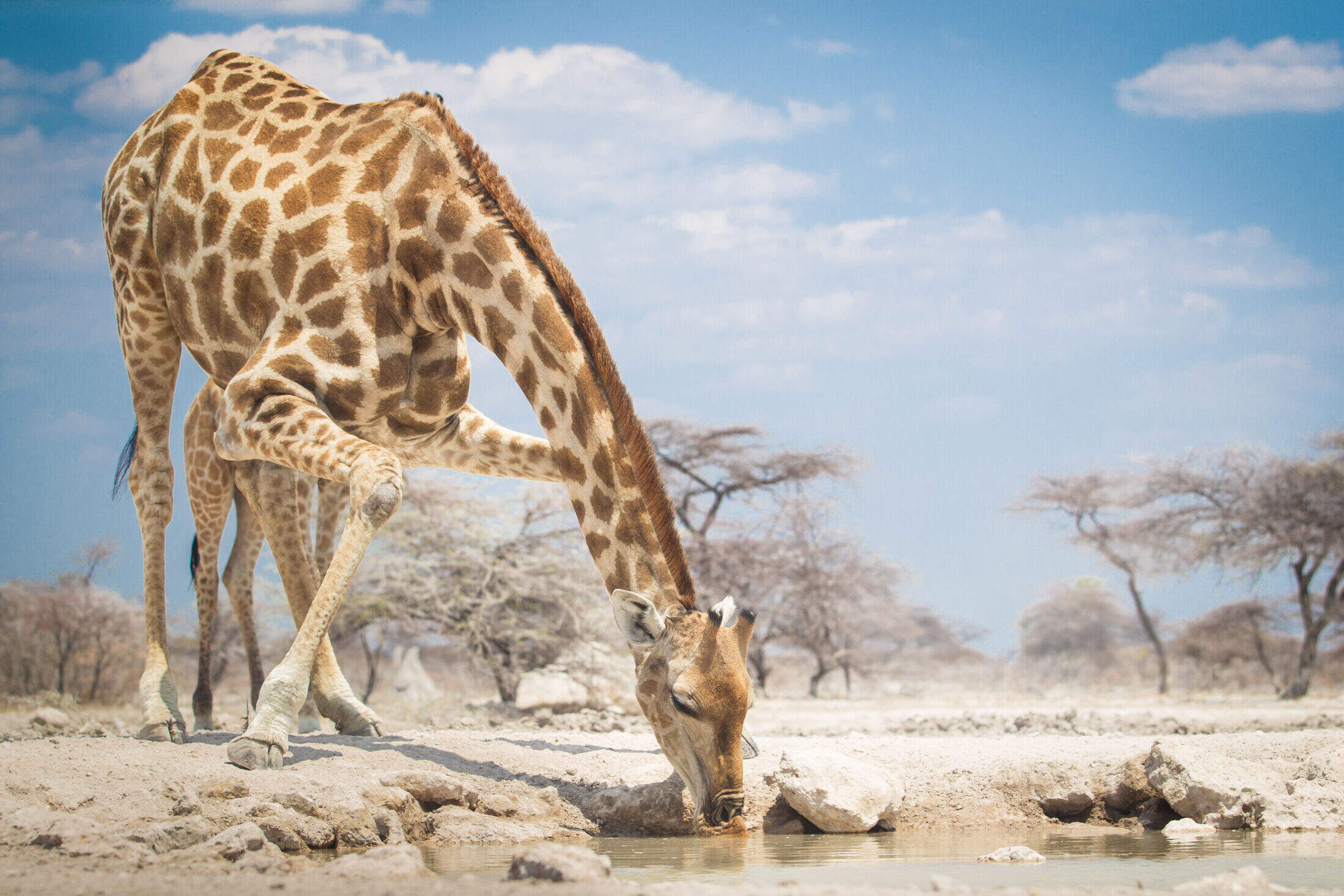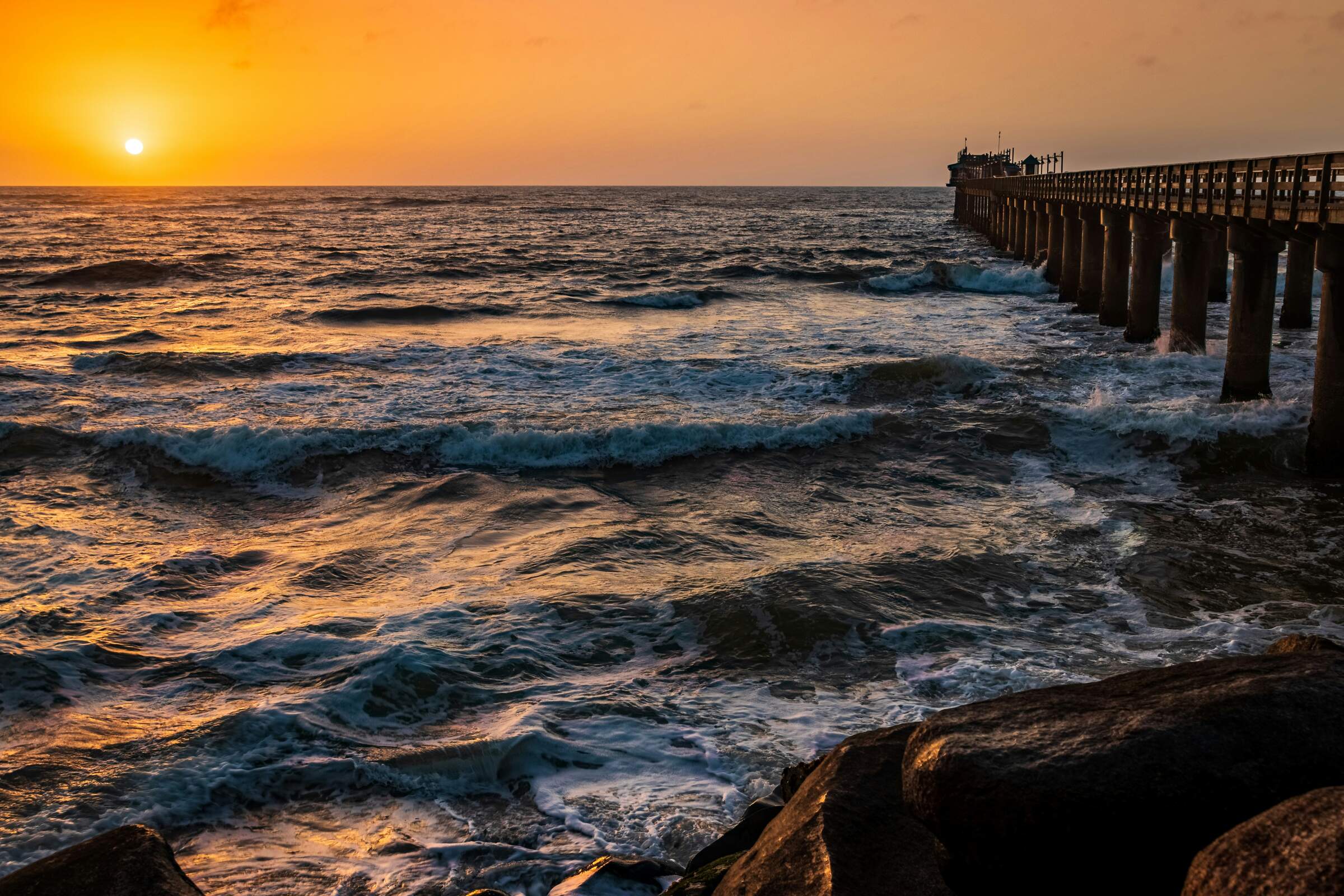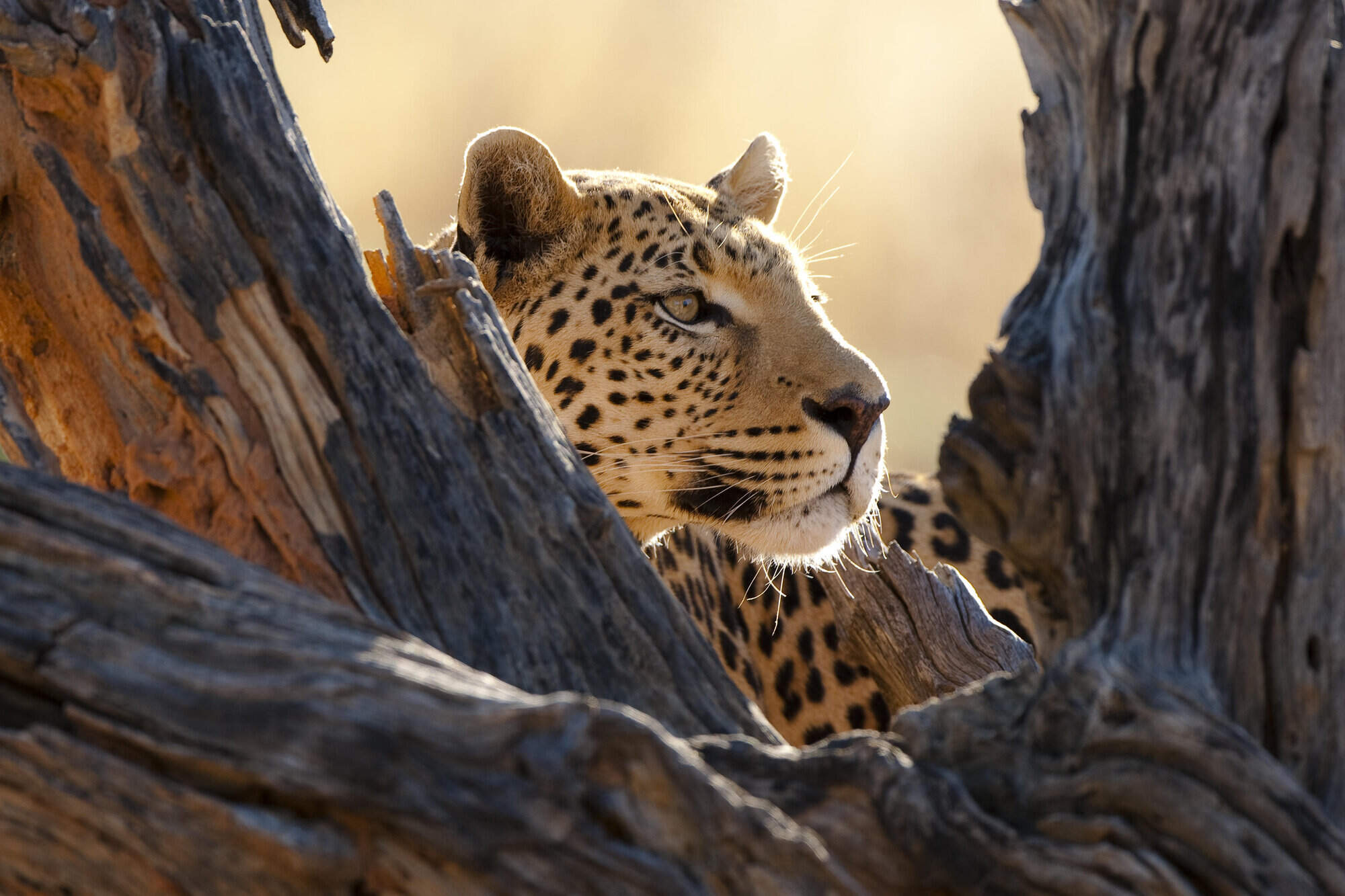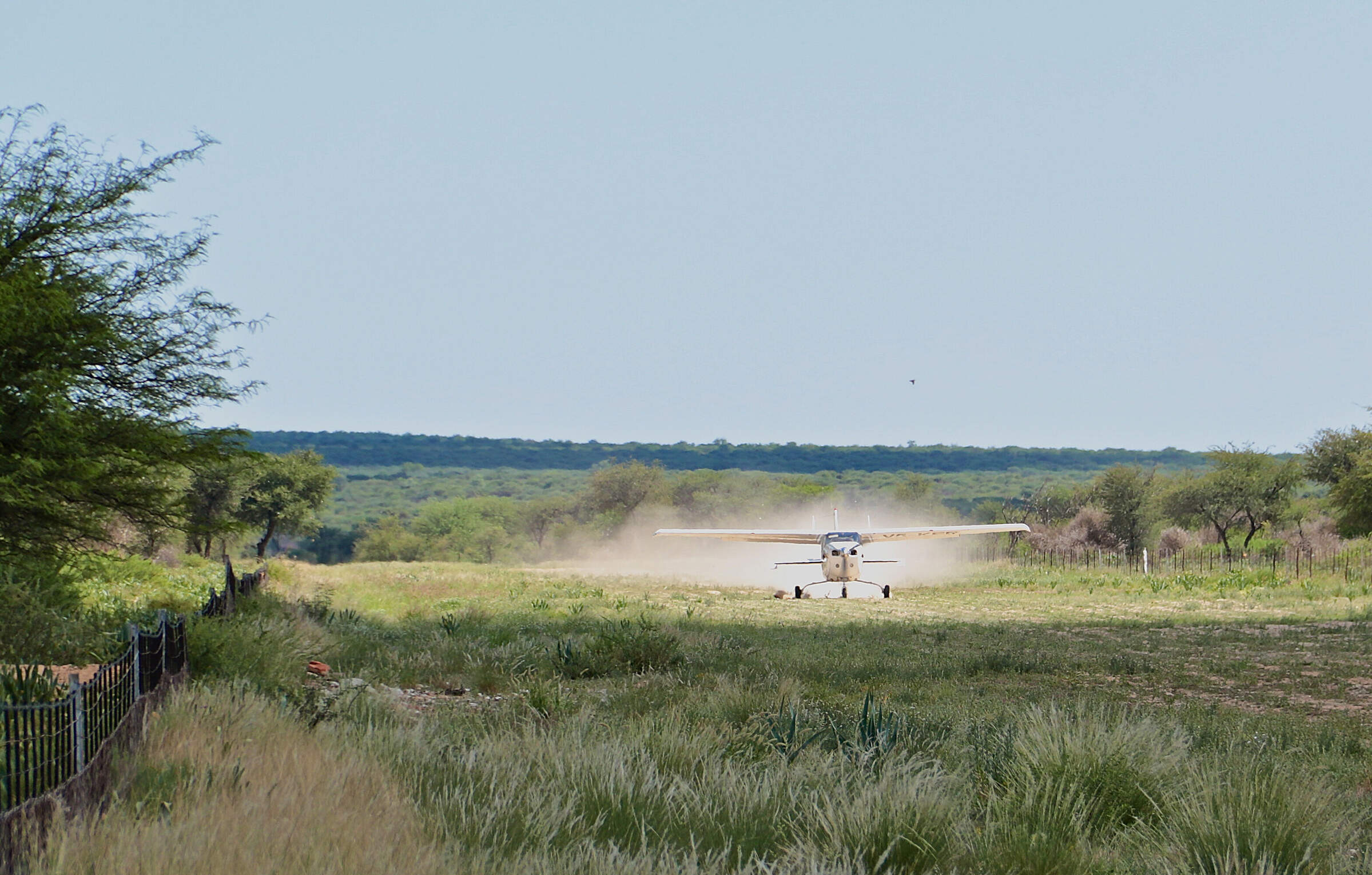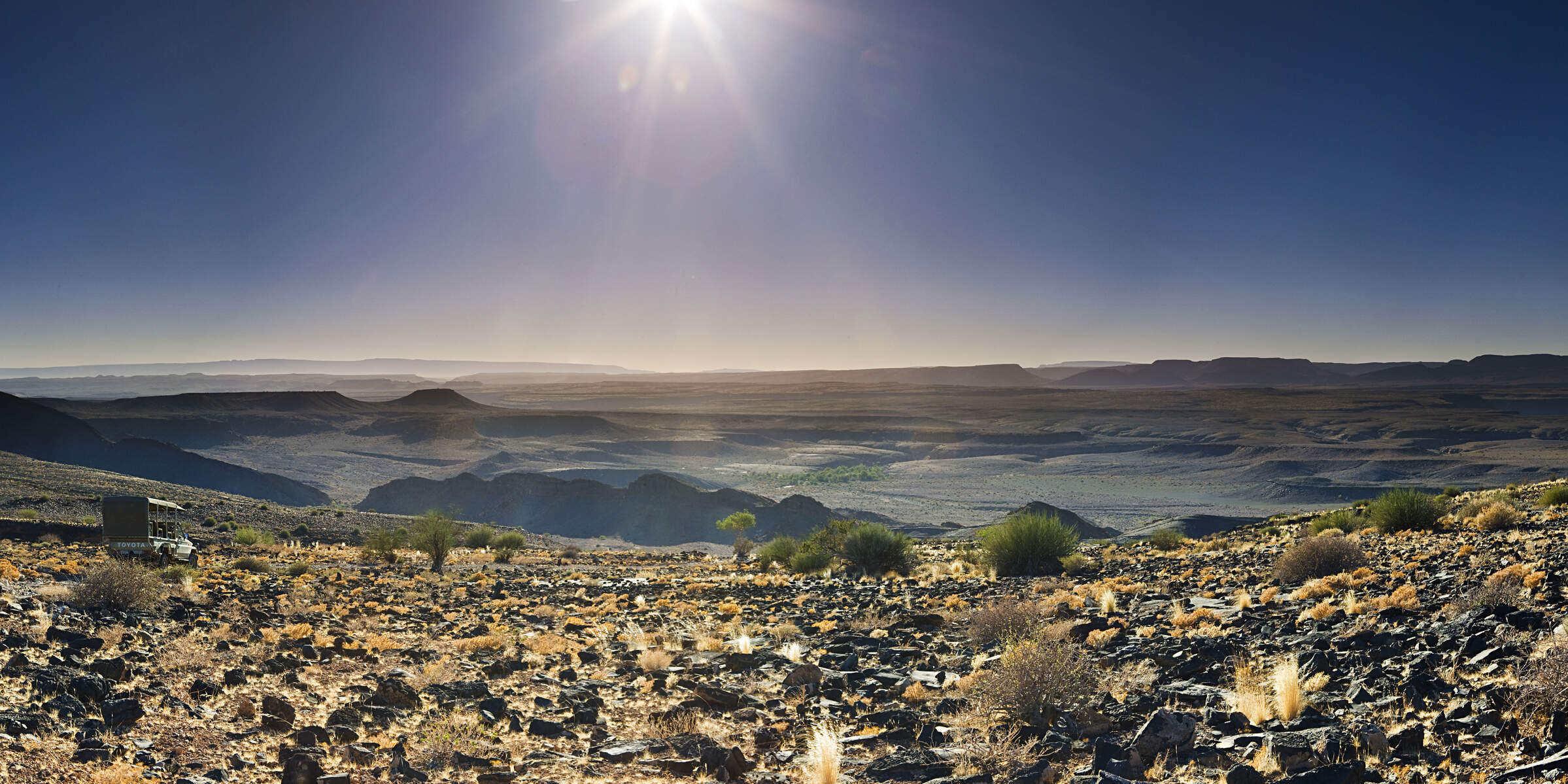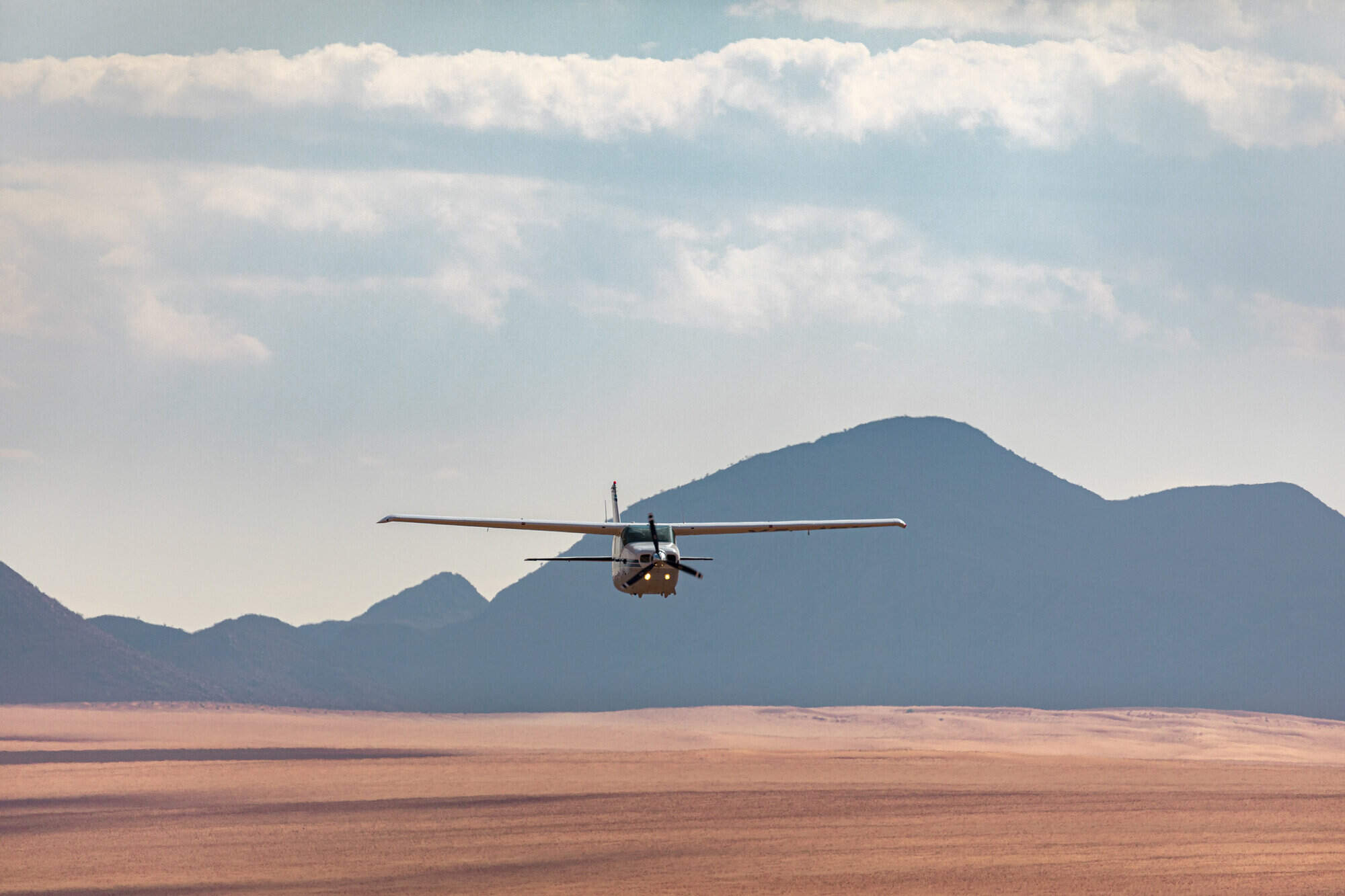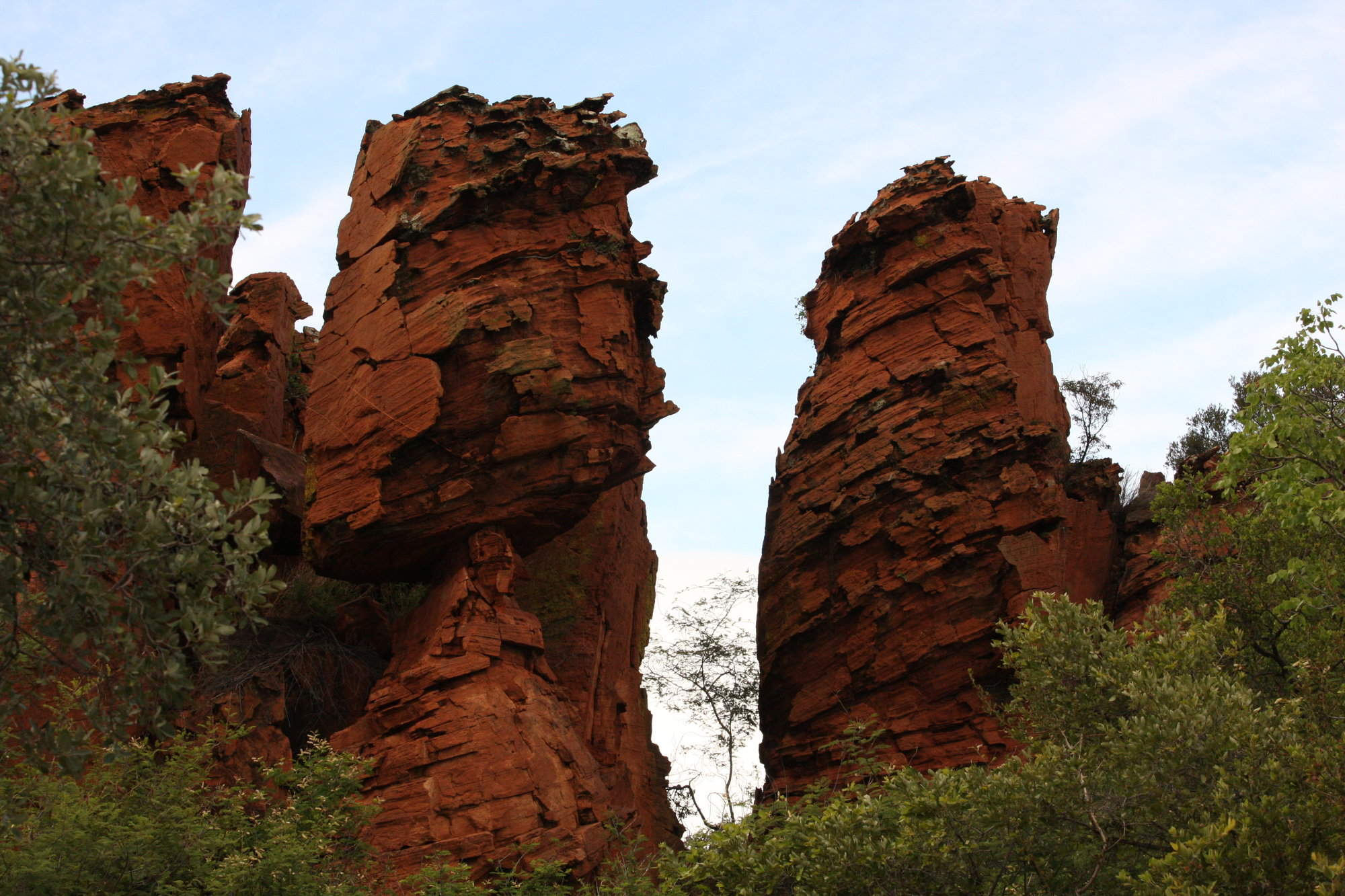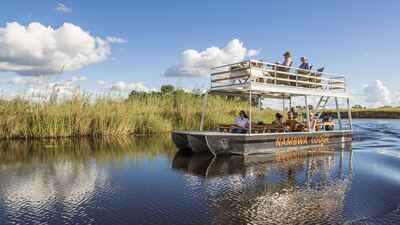
Enjoy river cruises, fishing trips & birding in the Caprivi
Elephants frequently cross the river to feed
Spot game from camp
The Caprivi is the only place to see aquatic animals in Namibia
Birds abound
Birds abound
The Caprivi is home to large elephant herds Jul-Sep
Water-based activities aren't the only option
Some lodges offer fine dining
You can almost guarantee spectacular sunsets
Caprivi Strip
Caprivi Strip
Veined by permanent rivers, the Caprivi is home to birds and animals that live almost nowhere else in Namibia.
African fish eagles perch on branches high above the water; a thrilling flash of blue marks the passage of a bejewelled kingfisher.
Sitatunga and red lechwe thrive within the wetlands of the national parks – Bwabwata, Mudumu and Nkasa Rupara – whose plains are home to Cape buffalo and sable antelope as well as elephant aplenty. The range of habitats make this an exceptional place for birding, as well; indeed, more species have been identified in the Mahango area of Bwabwata than anywhere else in Namibia.
While often explored from a 4WD, this world of plenty is perfect for boating, at its best in the early morning or towards sunset. Whether you’re chugging along the broad reaches of the Kavango or meandering through picturesque channels, that’s a real bonus in a largely dry country. And if you fancy a spot of fishing, that too is on the agenda at many of the riverside camps.
Even away from the parks, the Caprivi – or Zambezi Region – feels very different. Smoke spirals up from fires in roadside villages, children play in the dirt, and foraging goats, cows and chickens present a constant hazard for drivers. Here and there, makeshift stalls offer drinks and local crafts, and the occasional small town offers up the essentials to passing travellers.
The Caprivi may not be on every traveller’s wishlist, but to come here is to experience a side of Namibia that is rarely seen – while staying in one of a handful of lodges whose standards of accommodation, food and guiding are among the best in the land.
And as a bonus, the region’s close proximity to the Victoria Falls presents a perfect add-on for many a self-drive safari.

Safaris visiting Caprivi Strip
Just ideas, we'll always tailor-make a trip for you
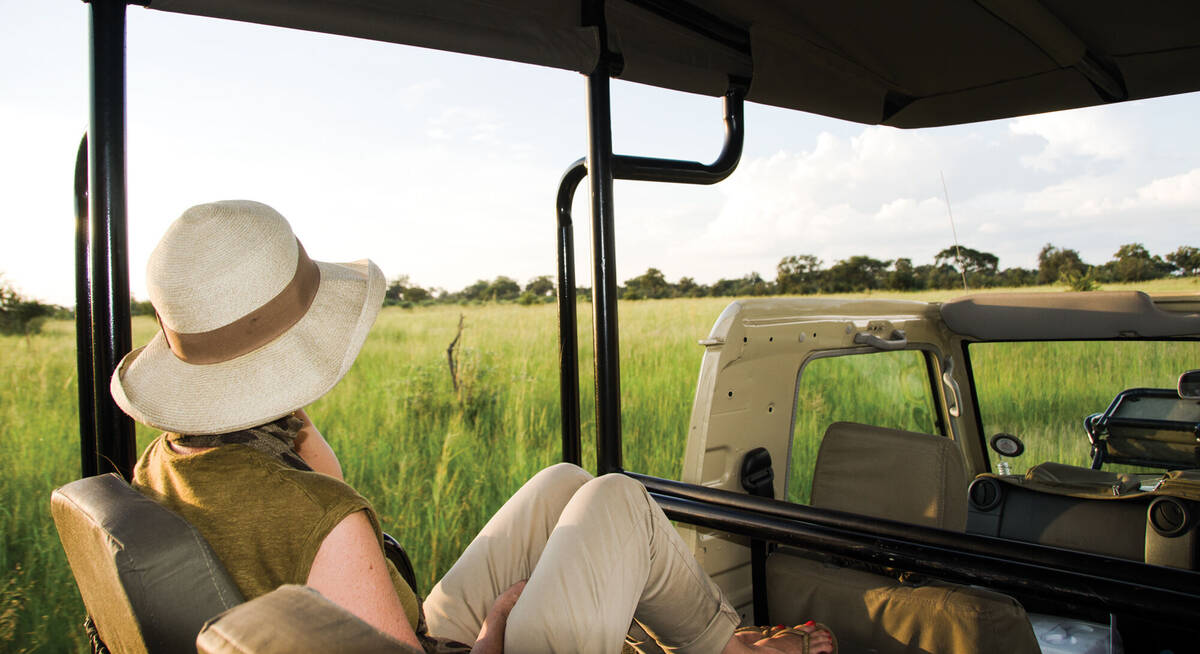
Rock Hare Self-drive Safari
20 days • 12 locations
WINDHOEK AIRPORT TO VICTORIA FALLS AIRPORT
An in-depth look at Namibia from the Namib Desert to the Caprivi, with additional stops in Botswana and Victoria Falls. This three-week adventure includes an unrivalled mix of environments and is great value.
US$7,230 - US$8,170 per person
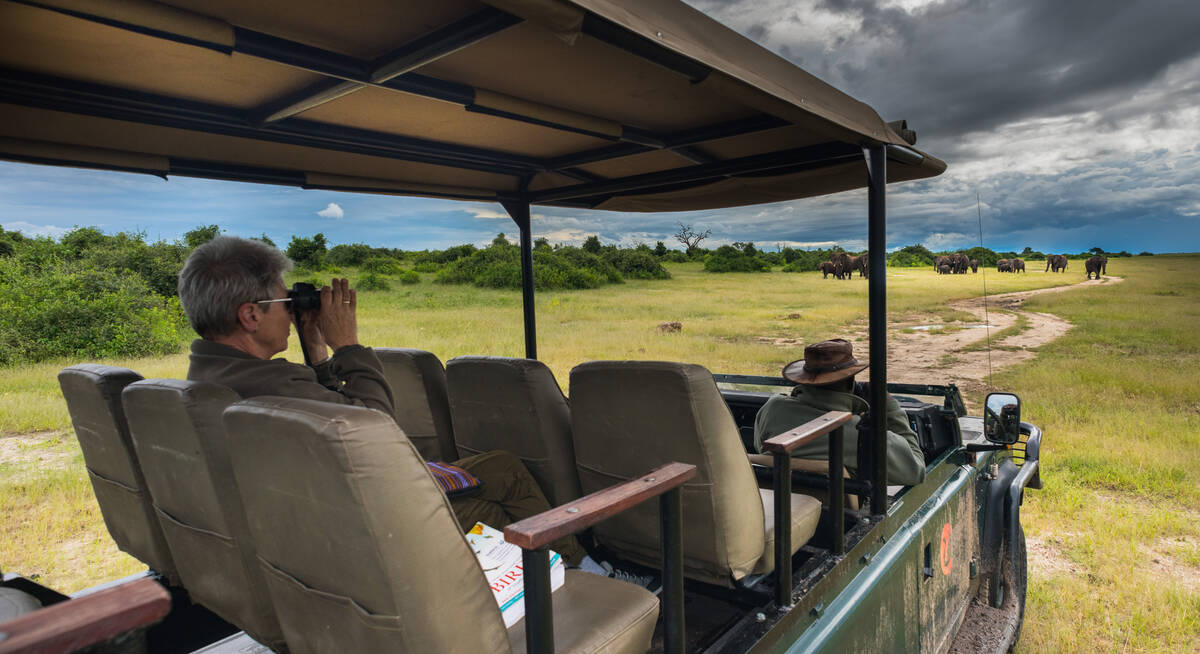
Pygmy Mouse Self-drive Safari
18 days • 10 locations
WINDHOEK AIRPORT TO VICTORIA FALLS AIRPORT
A truly epic southern African self-drive safari adventure from Namibia’s mountains and deserts, along the lush Caprivi Strip to Botswana and Victoria Falls in Zimbabwe, staying at luxury lodges throughout.
US$8,580 - US$10,260 per person

Sable Self-drive Safari
12 days • 7 locations
WINDHOEK AIRPORT TO VICTORIA FALLS AIRPORT
A great-value southern African self-drive adventure from Namibia along the Caprivi Strip to Botswana and Zimbabwe, combining other-worldly landscapes, unforgettable wildlife spectacles and rarely visited places, and ending at Victoria Falls.
US$8,220 - US$9,120 per person

Great Egret Safari
12 days • 4 locations
MAUN AIRPORT TO VICTORIA FALLS AIRPORT
This wonderfully varied adventure combines Botswana's Okavango Delta and a live-aboard houseboat safari on the Chobe River, with big game in Zimbabwe's dry Hwange National Park and the stupendous Victoria Falls.
US$10,330 - US$17,370 per person
Most recent reviews of our safaris to Caprivi Strip
Click below to browse all 284 reviews from Caprivi Strip. All from our travellers; all are in full & unedited.
Arrived 15 Mar 2025, 20 nights
"My March 2025 trip"
Overall rating: Excellent
Arrived 10 Sep 2024, 23 nights
"Botswana & Zambia Sept 2024"
Overall rating: Excellent
Arrived 5 Sep 2024, 18 nights
"My Sep 2024 trip"
Overall rating: Excellent
Arrived 4 Sep 2024, 14 nights
"My Sep 2024 trip"
Overall rating: Excellent
Arrived 8 Aug 2024, 19 nights
"My Aug 2024 trip"
Overall rating: Excellent
Arrived 19 Jul 2024, 14 nights
"My Jul 2024 trip - Botswana & Namibia"
Overall rating: Excellent
Arrived 10 Jul 2024, 13 nights
"My Jul 2024 trip"
Overall rating: Excellent
Arrived 21 Jun 2024, 13 nights
"My Jun 2024 trip"
Overall rating: Excellent
Arrived 16 Jun 2024, 14 nights
"My Jun 2024 trip"
Overall rating: Excellent
Arrived 14 Jun 2024, 22 nights
"Our Botswana Safari (June 2024)"
Overall rating: Excellent
Where to stay in Caprivi Strip
Our suggestions for safari camps in Caprivi Strip
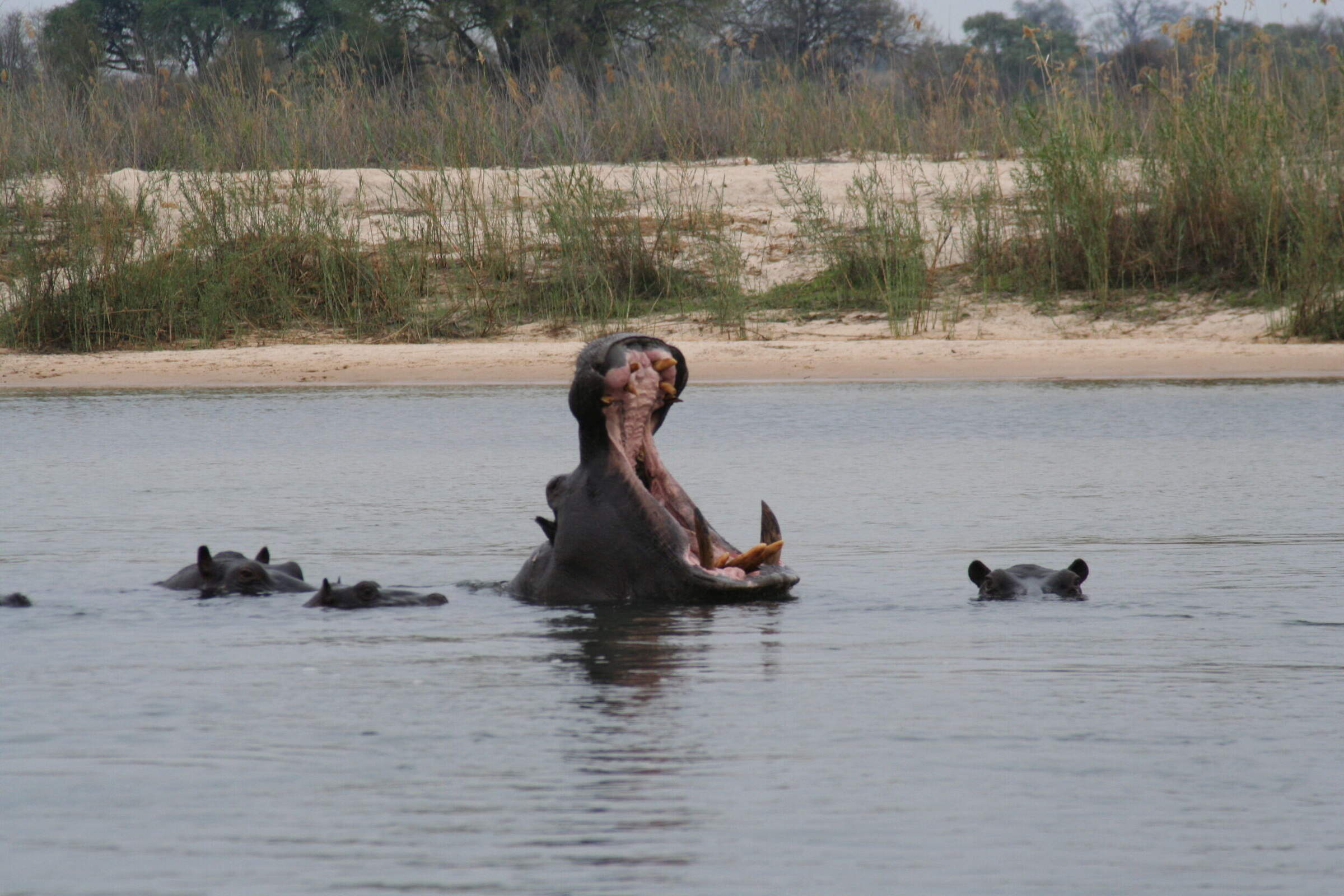
Ndhovu Safari Lodge
Ndhovu is a simple riverside lodge, with tents that are reminiscent of safaris a decade or two ago.
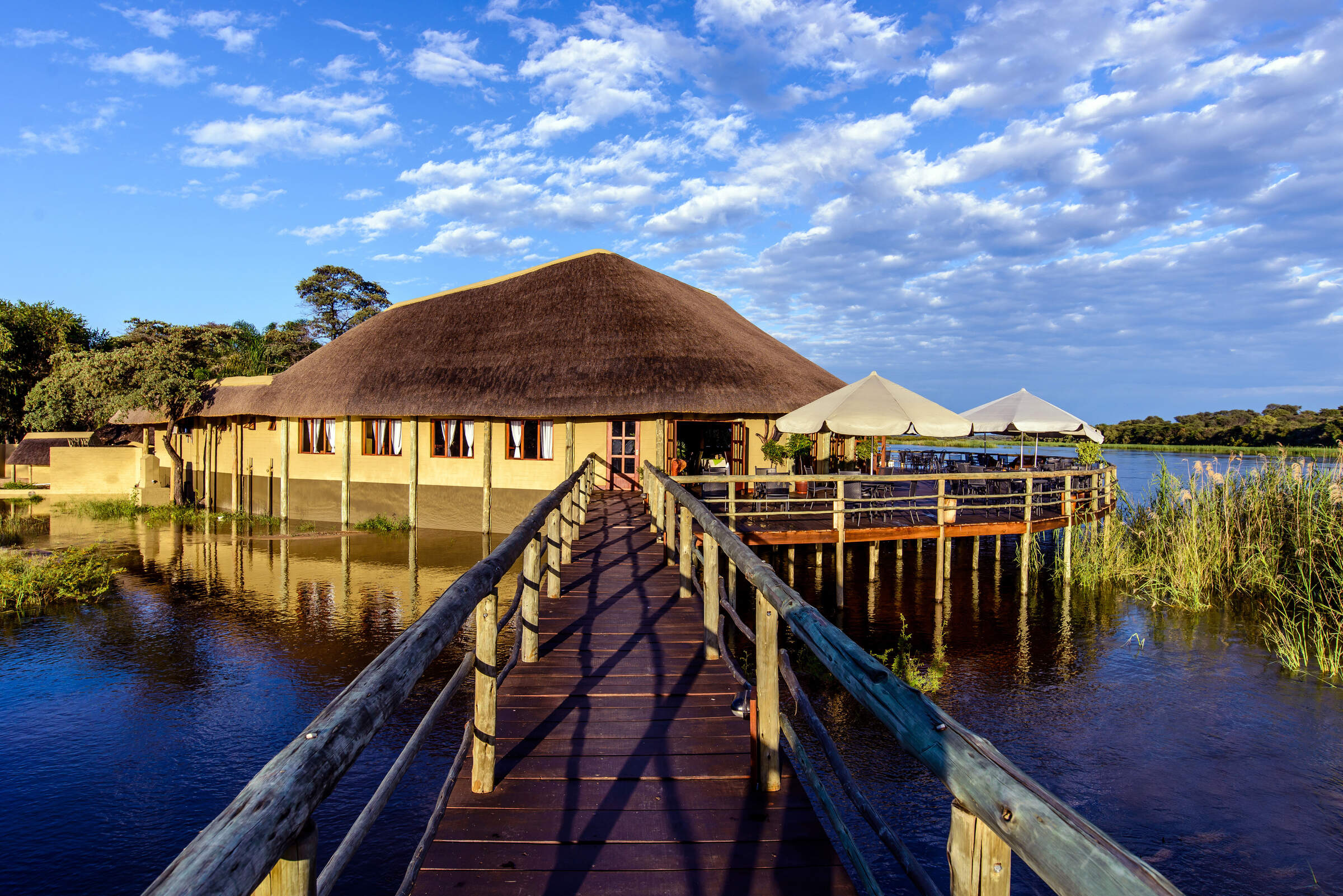
Hakusembe Lodge
Hakusembe River Lodge is a substantial lodge with a superb location on the Kavango River.
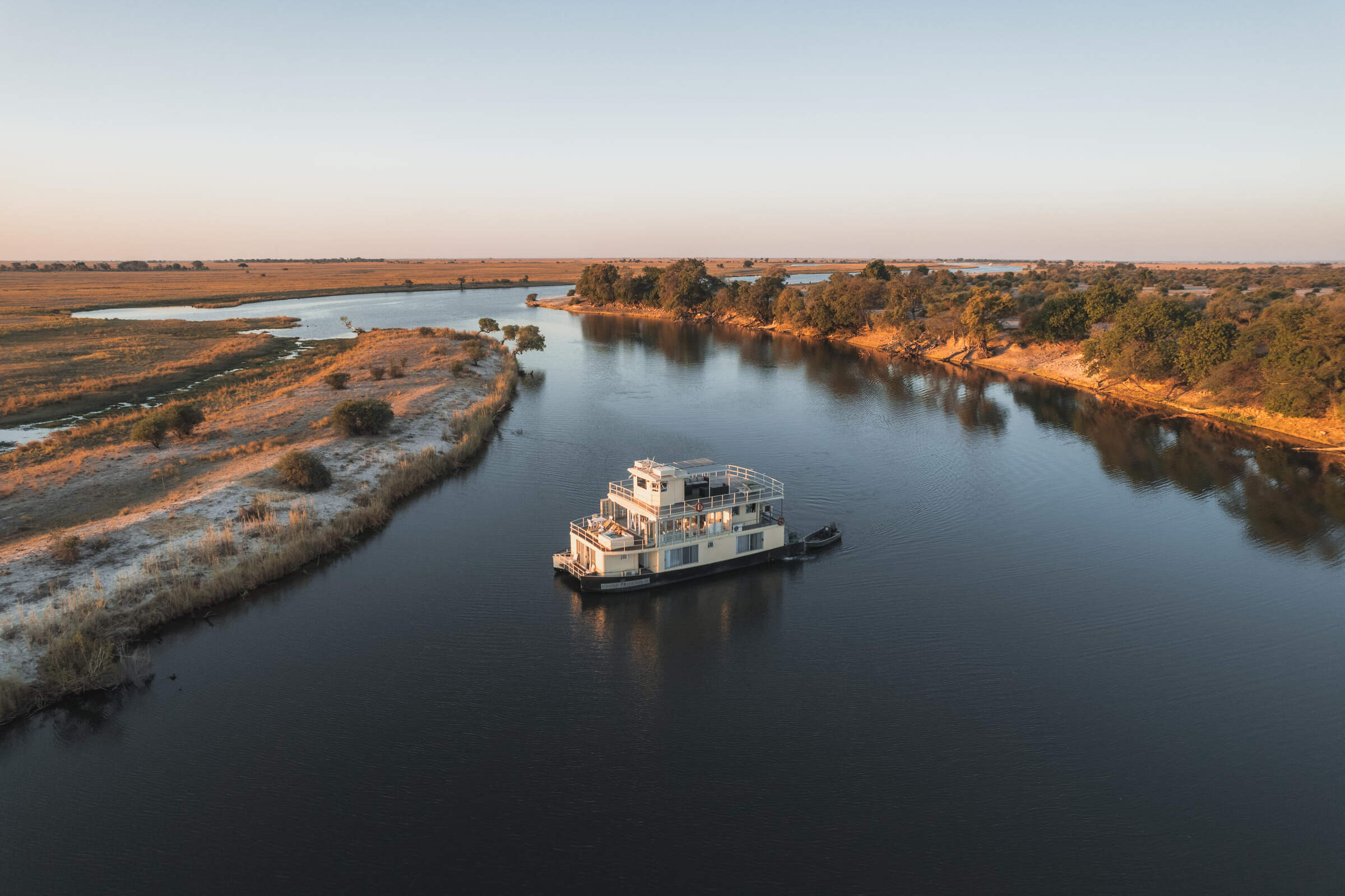
Chobe Princesses
The Chobe Princess houseboats offer a memorable way to explore the Chobe and Zambezi Rivers in Namibia's Caprivi. Perfect for a couple or for a group of family or friends.

Lianshulu Lodge
Beside the Kwando River, within Mudumu National Park, Lianshulu is a small safari lodge offering 4WD safaris and river trips – with particularly good birdlife.
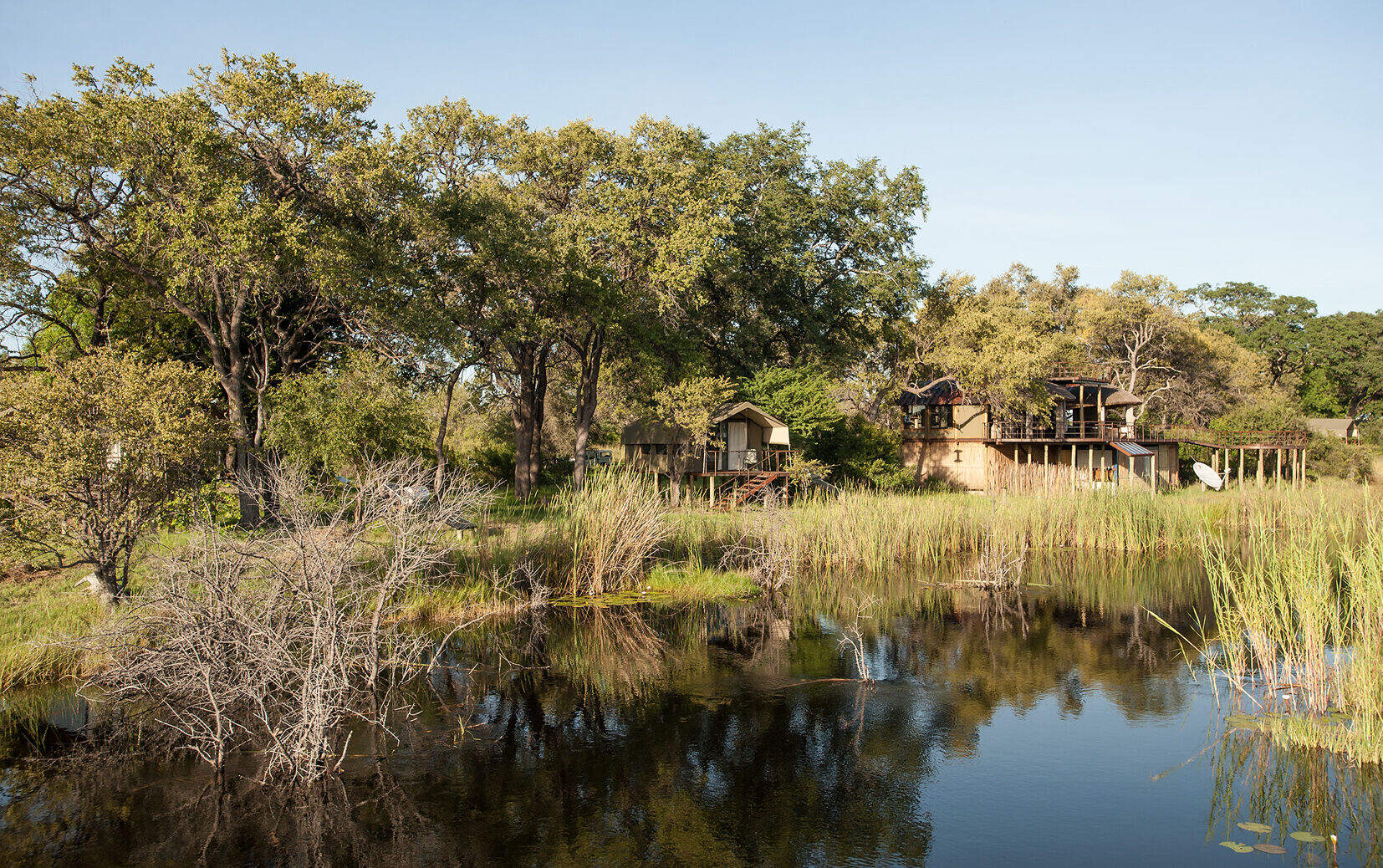
Nkasa Lupala
Peaceful Nkasa Lupala is a comfortable lodge in a remote and little-explored area close to Nkasa Rupara National Park.

Nunda River Lodge
NNunda River Lodge overlooks a pretty part of the Kavango River near Popa Falls and the productive Mahango National Park.

Camp Kwando
Near to Mudumu National Park, Camp Kwando is a comfortable and unfussy option with opportunities for game drives, boat safaris and fishing.
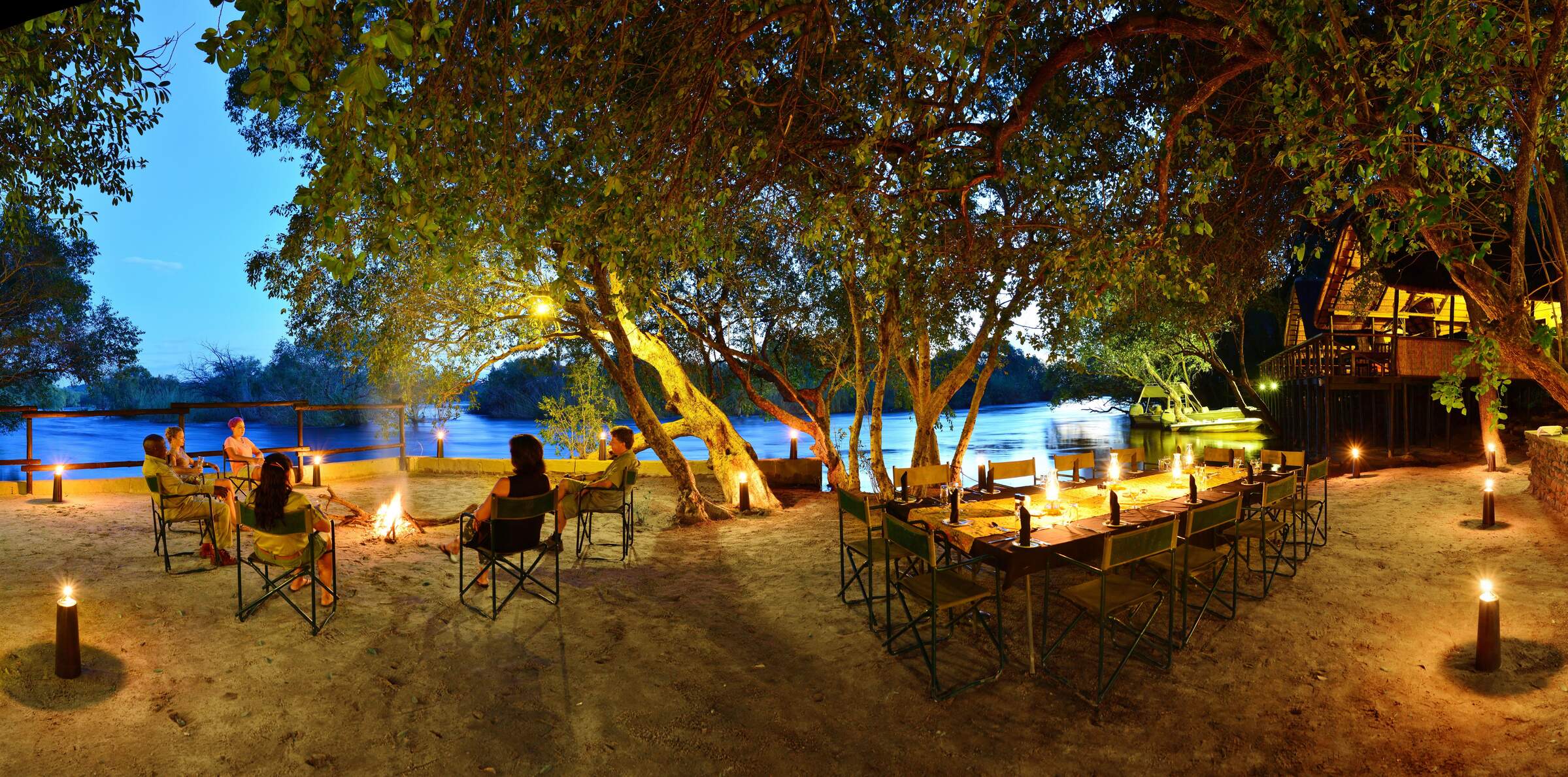
Ichingo Chobe Lodge
Safari holiday in Namibia's Caprivi Strip, staying at Ichingo Chobe River Lodge on Impalila Island.

Nambwa Tented Lodge
A beautiful safari lodge In the remote Bwabwata National Park, Nambwa Tented Lodge brings serious comfort to a relaxing safari.

River Dance
Build on stilts on the banks of the Kavango River, River Dance Lodge has great views, a relaxed ambience and excellent birdlife.
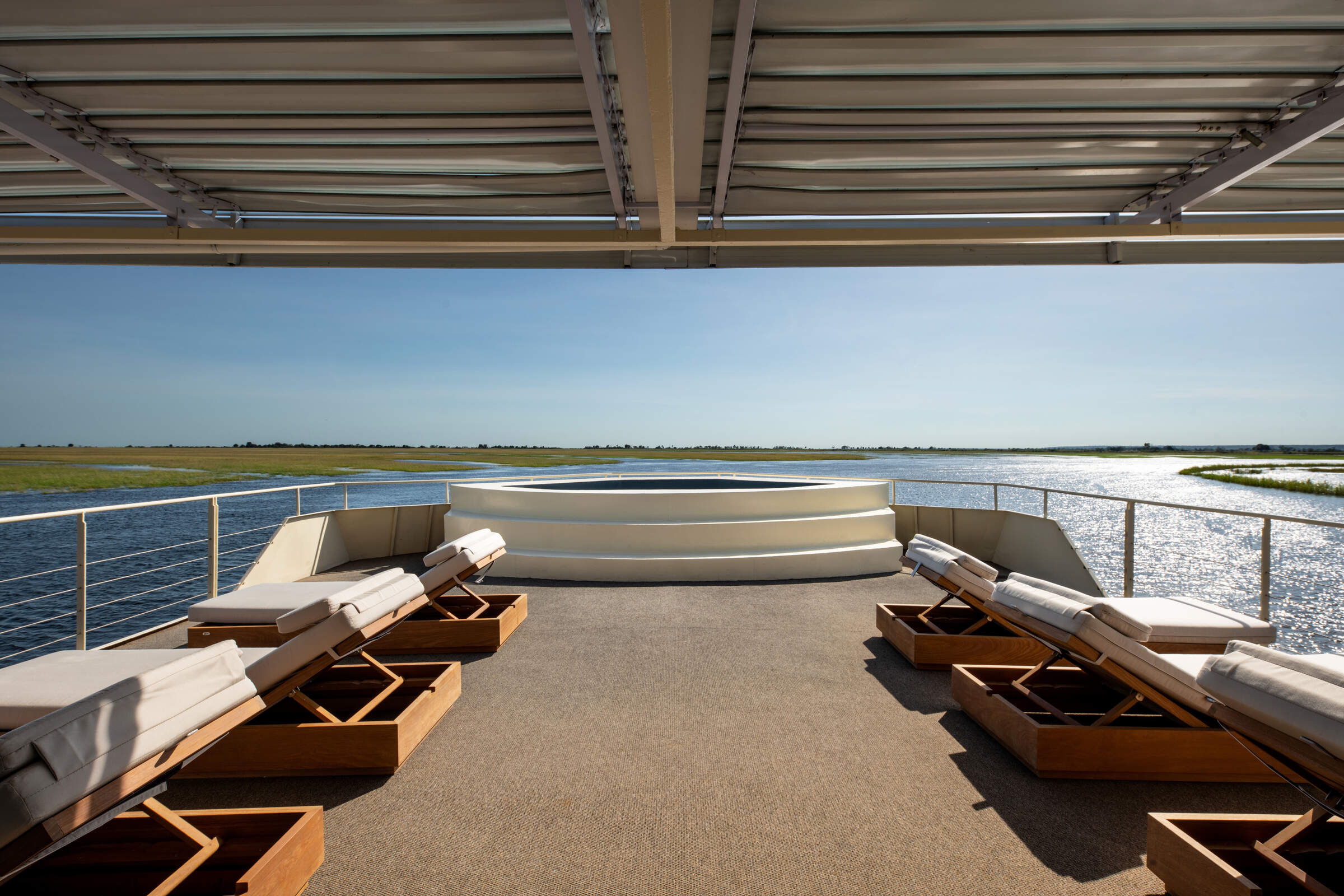
Zambezi Queen
The Zambezi Queen offers luxurious two- and three-night cruises along the game-rich Chobe River, including game viewing by small boat and 4WD as well as catch-and-release fishing.

Taranga Lodge
Situated on the banks of the Kavango, Taranga Safari Lodge works as a convenient stopover before going onto explore the Caprivi.
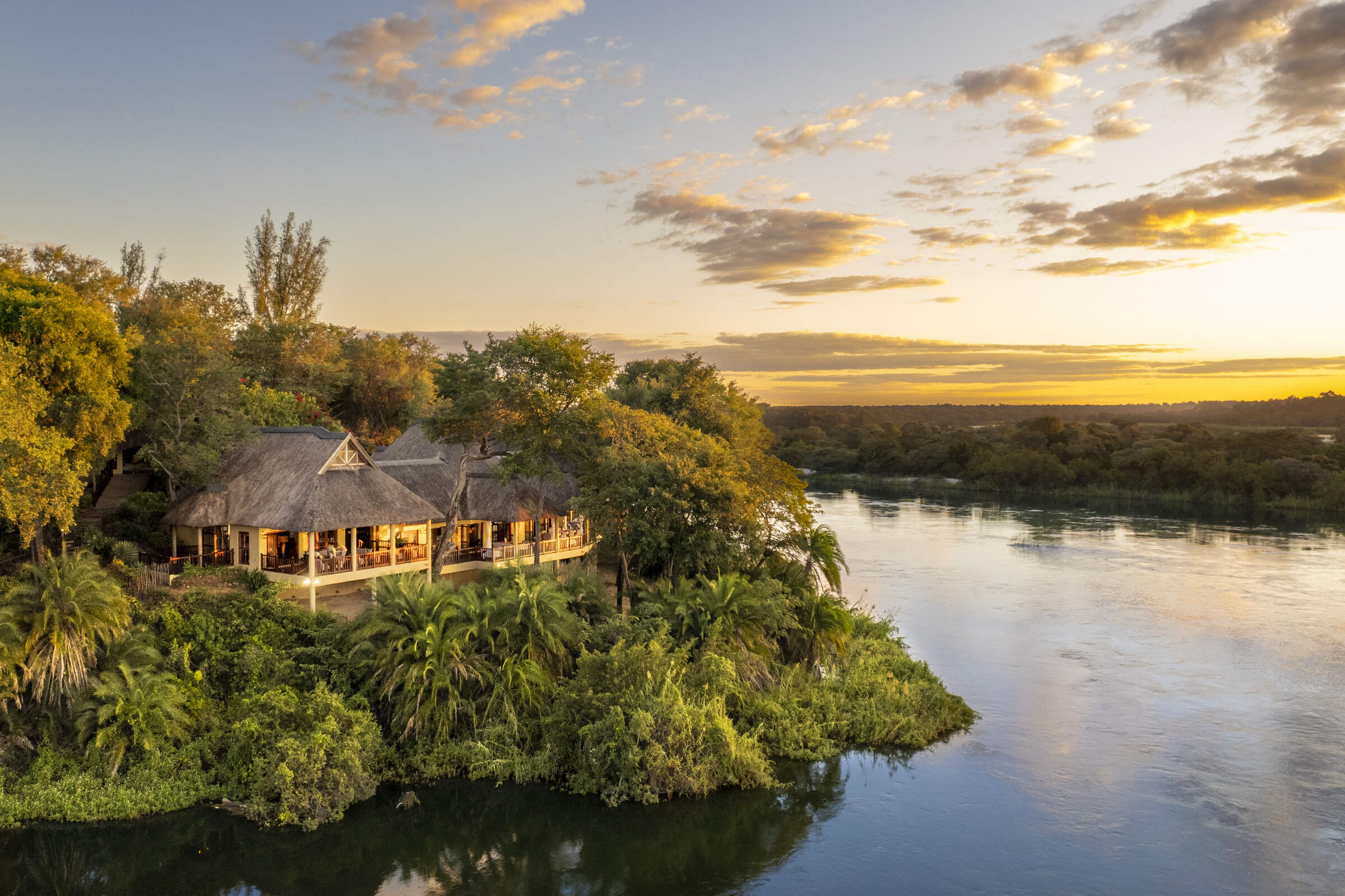
Divava Lodge & Spa
The substantial Divava Okavango Lodge & Spa offers plenty of pampering opportunities in an unspoilt riverside setting
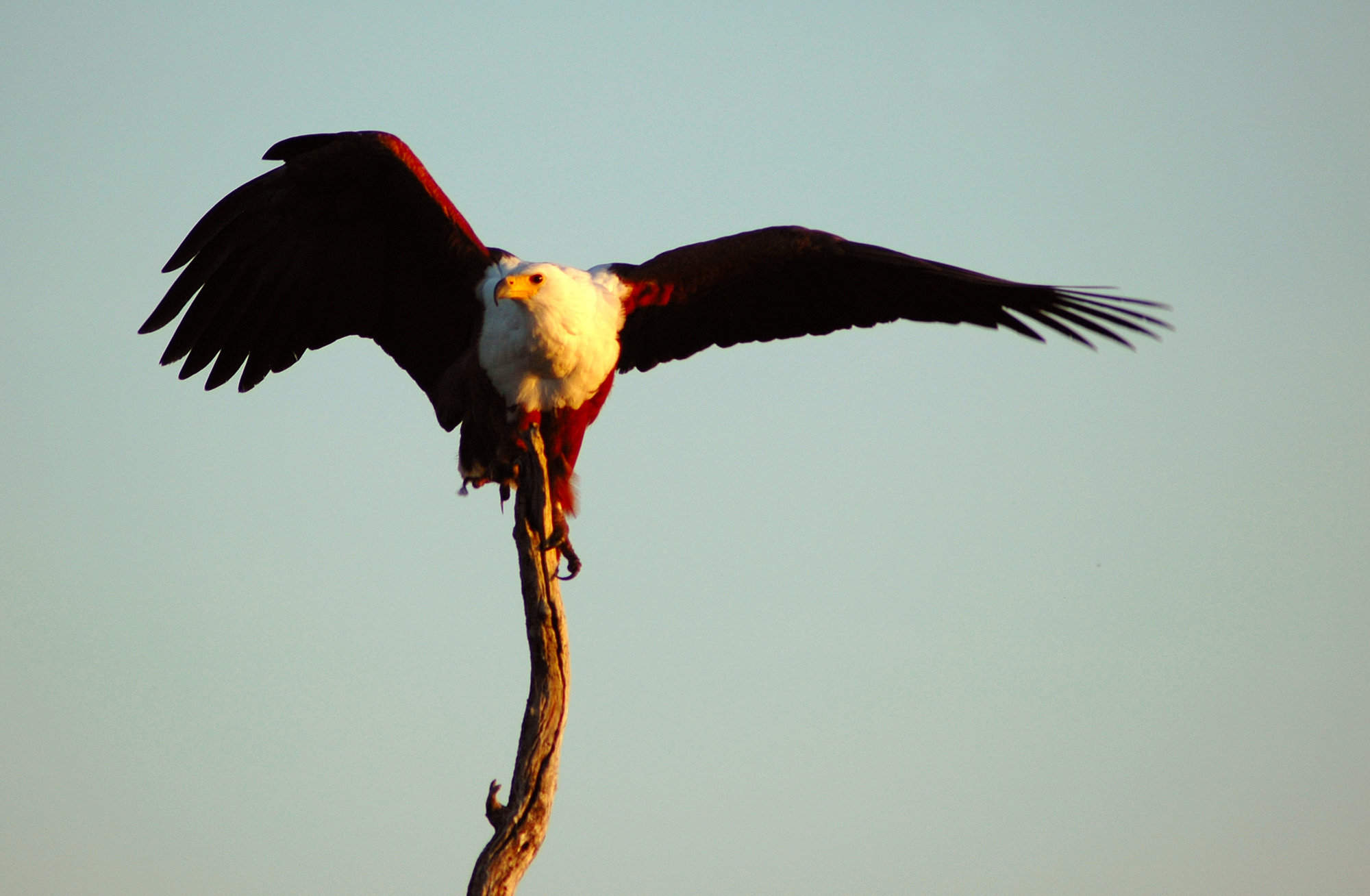
Cascade Island Lodge
Cascade Island Lodge, near Kasane in the Caprivi Strip is a very luxurious, high end option for those seeking peace and privacy on the Zambezi River.

Shametu Lodge
Shametu River Lodge has the best views of the Popa Rapids of any private lodge in the Divundu area.
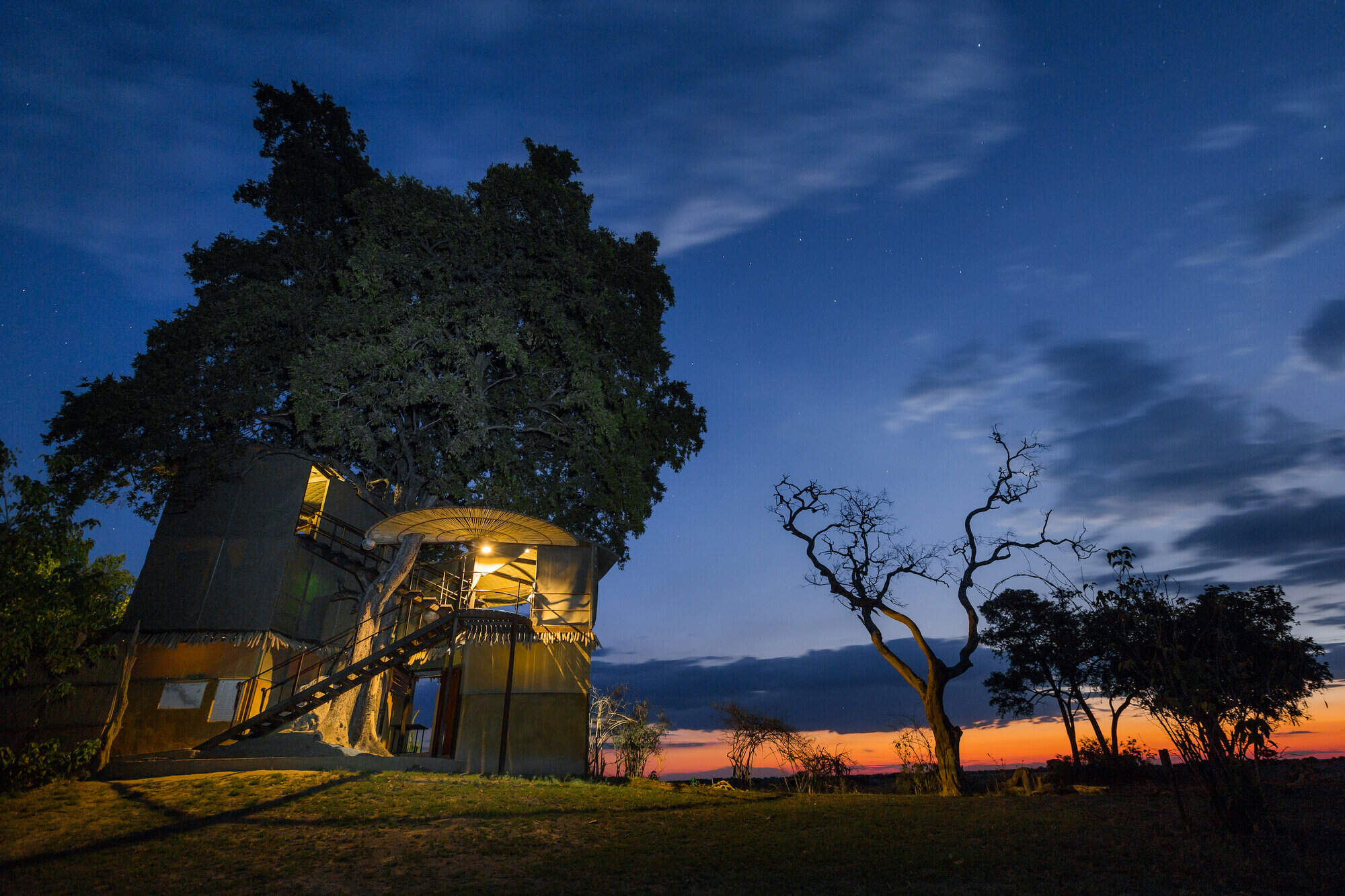
Jackalberry Camp
Jackalberry Camp is uniquely situated in the Nkasa Rupara National Park affording unrivalled access to this little-visited corner of Namibia.
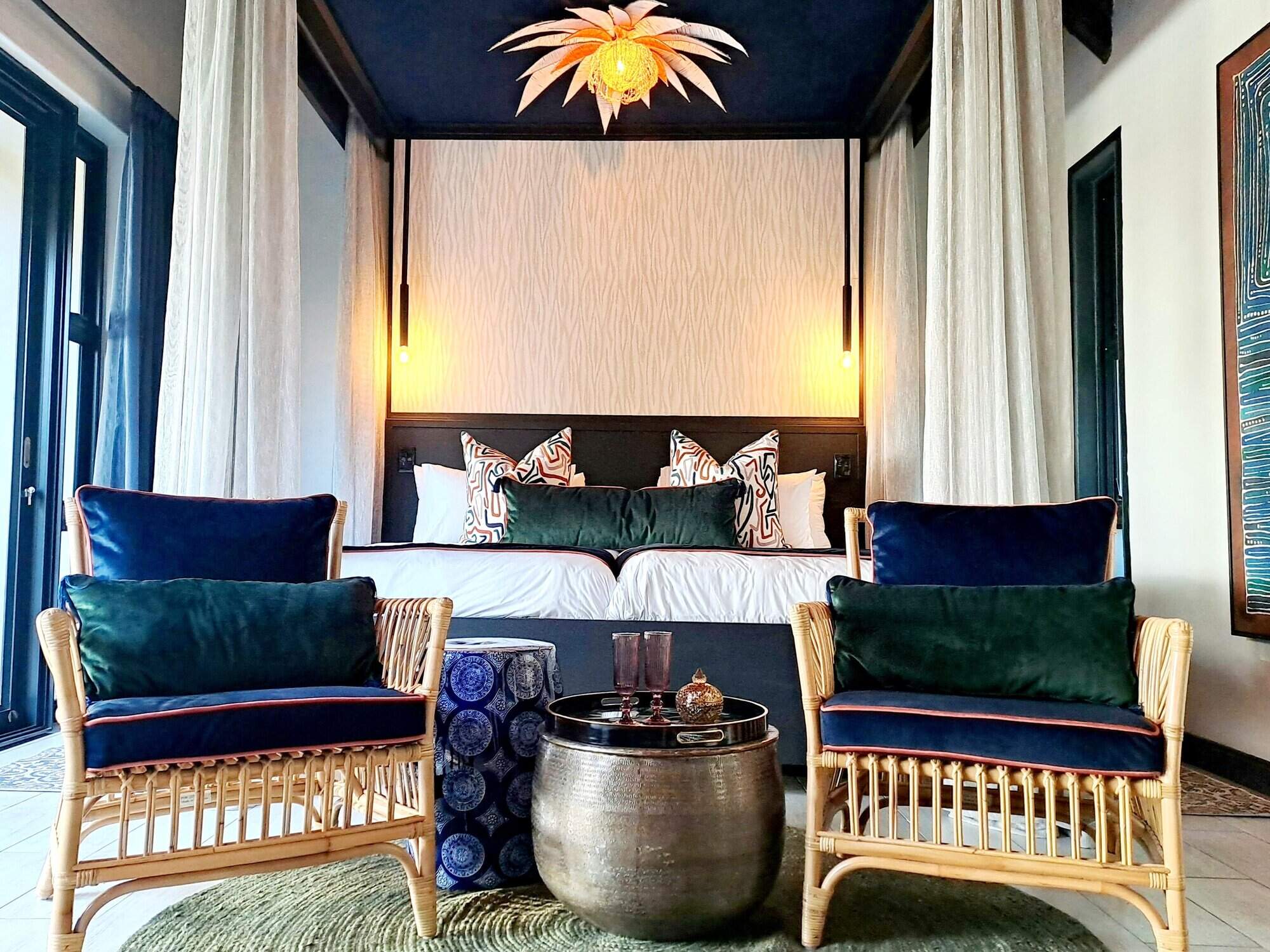
Namushasha Lodge
One of the larger lodges in the Bwabwata National Park, Namushasha is an economic option with an attractive river-side location.
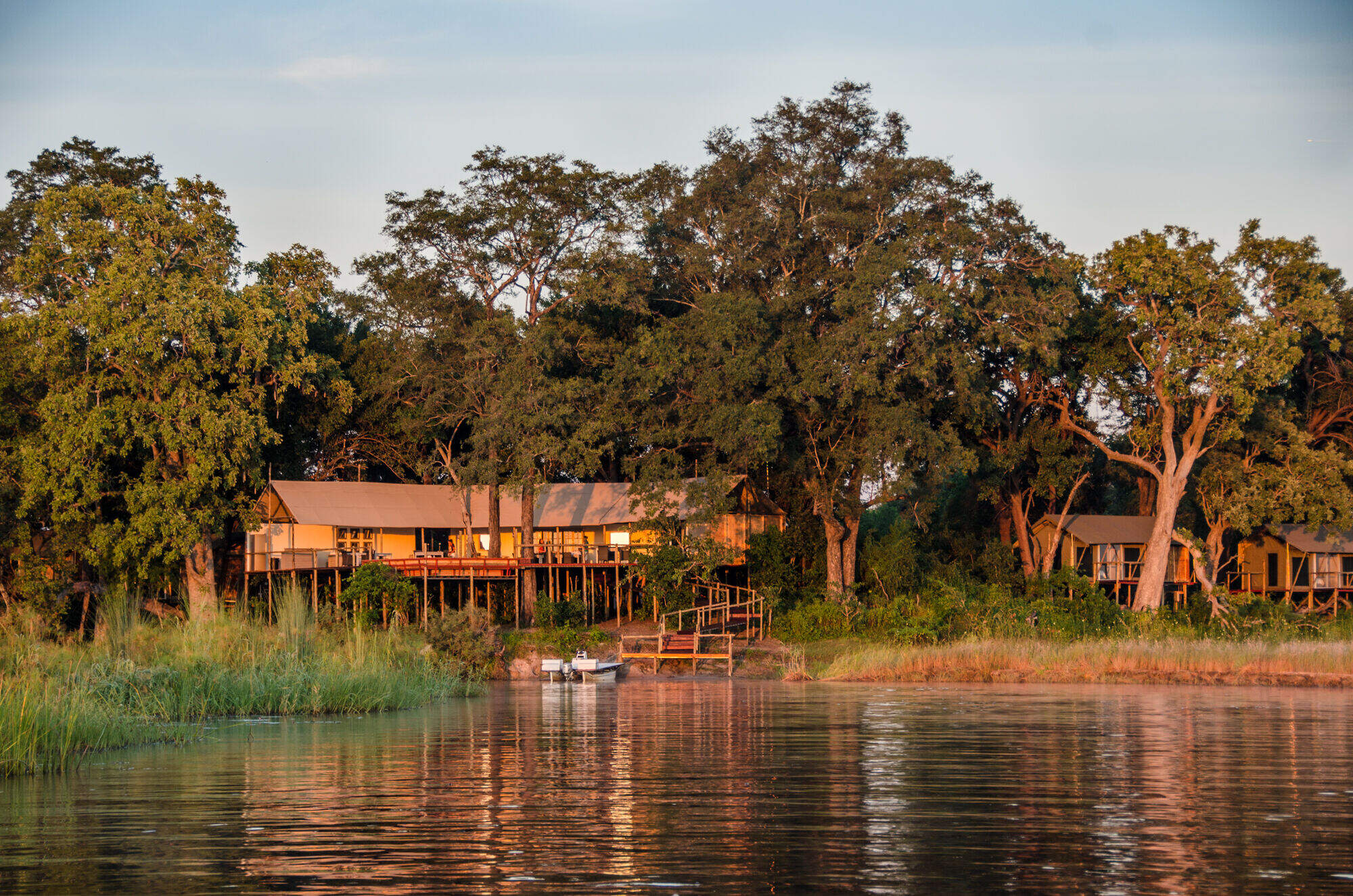
Kazile Island Lodge
On an island in the Kwando River within Bwabwata National Park, the remote Kazile lsland Lodge offers games drives, bush walks and boat cruises.

Serondela
Accessible only by river, Serondela combines the remoteness of Namibia’s Caprivi Strip with access to Botswana’s flagship Chobe National Park.

Chobe Savanna Lodge
Chobe Savanna Lodge stands opposite Chobe National Park, Botswana. Click here to learn more about the area and your options for a safari there.

Chobe Water Villas
Chobe Water Villas is a beautiful and thoughtfully designed lodge, in a great location on the Namibian banks of the Chobe River.
Our travellers’ wildlife sightings in Caprivi Strip
This is their success for sightings in Caprivi Strip. Click on a species for more detail. How we work this out.

85% success

81% success

67% success

66% success

62% success

46% success

38% success

31% success

26% success

19% success

15% success

14% success

4% success

3% success

3% success

1% success

0% success

0% success
When to go to the Caprivi Strip
The Caprivi Strip (Zambezi Region) has distinct wet and dry seasons.
The wet season, from around November to April, features hot, humid days and frequent thunderstorms. Wildlife disperses, making game viewing challenging but rewarding.
The dry season, from May to October, offers cooler temperatures and excellent wildlife viewing, especially in Bwabwata and Mudumu National Parks, as animals gather around water sources. Boat safaris on the Zambezi and Kwando rivers provide spectacular sightings. Birdlife is abundant year-round, with migratory species arriving during the wet season.
Jan
Feb
Mar
Apr
May
Jun
Jul
Aug
Sep
Oct
Nov
Dec
Caprivi Strip in January
January marks the heart of the rainy season in the Caprivi Strip. The Zambezi and Kwando rivers swell, nourishing the lush landscapes of Bwabwata and Mudumu National Parks. Rainfall can be heavy but localised, with temperatures around 30°C/86°F.
The verdant environment makes a refreshing change, especially in typically drier areas. Birdlife is abundant, with many species in full breeding plumage and migratory birds present in force. In Nkasa Rupara National Park, the abundant water allows wildlife to disperse, making it more challenging to spot. However, boat cruises along the major rivers offer excellent opportunities for wildlife viewing and birdwatching.
- Variable weather: hot and dry or humid with rain
- Occasional localised thunderstorms in the region
- Abundant birdlife, especially migratory species
- Wildlife dispersed, harder to spot in Bwabwata
- Few tourists, low rates at lodges and camps
Our view
This is not a great time to visit
Weather in January
Caprivi Strip in February
February is the wettest month in the Caprivi Strip, with the Zambezi Region experiencing some of the heaviest rainfall. The Kavango and Zambezi rivers reach their peak levels, creating a lush, green paradise.
Days alternate between clear, hot and humid, and cooler with building clouds culminating in spectacular thunderstorms. These storms can cause flash floods, bringing ephemeral rivers to life and making travel more challenging, especially in remote areas like Khaudum National Park. The landscape feels vibrant and alive; insects and smaller animals are more easily seen in Bwabwata and Mudumu National Parks. Many birds and animals are raising their young. However, the abundance of water and thicker vegetation can make it harder to spot larger wildlife. Boat safaris along the Chobe River offer excellent game viewing opportunities.
- Weather alternates between hot/dry and humid/rainy
- Thunderstorms meander over the lush landscape
- Vibrant birdlife in wetlands and floodplains
- Wildlife scattered across Bwabwata National Park
- Low tourist numbers, great deals on accommodation
Our view
This is not a great time to visit
Weather in February
Caprivi Strip in March
March usually sees the main rains in the Caprivi Strip tailing off, though precipitation varies across the region. Many days are clear with strong sun, while others may end with short, spectacular thunderstorms. As the month progresses, these rains reduce in frequency and volume. The landscape remains vivid and green, particularly in Bwabwata and Mudumu National Parks.
Wildlife viewing can be challenging as animals disperse, but patient observers may spot young animals and a variety of bird species in breeding plumage. The Kwando and Zambezi rivers remain high, offering excellent opportunities for boat safaris and fishing. Impalila Island becomes more accessible as water levels start to recede.
- Weather varies: clear and hot or cloudy and humid
- Thunderstorms decrease as the month progresses
- Animals well-fed after months of plentiful food
- Wildlife viewing challenging in Bwabwata Park
- Few visitors, low rates at lodges and camps
Our view
A good time to visit, with pros & cons
Weather in March
Caprivi Strip in April
April in the Caprivi Strip is characterised by increasingly dry weather, with temperatures starting to fall. Days remain pleasantly warm, and humidity is still high, but nights start to have a slight chill. The recent rains leave the region lush and green, particularly in Bwabwata and Nkasa Rupara National Parks.
Animals are in excellent condition, often with fast-growing young. As the atmosphere clears, photographers can capture spectacular landscapes and healthy wildlife. Stargazing becomes more rewarding as night skies clear.
In the northern parks like Mudumu and Bwabwata, water and food remain plentiful, so big game can be more dispersed. However, boat safaris along the Zambezi and Chobe rivers continue to offer excellent wildlife viewing opportunities. April is an ideal time for birdwatching, with many migratory species still present.
- Nights become cooler and drier in the region
- Easter sees a slight increase in visitor numbers
- Wildlife still dispersed in Bwabwata National Park
- Migratory birds begin their northward journey
- Lush green landscapes and crisp, clean air
Our view
A good time to visit, with pros & cons
Weather in April
Caprivi Strip in May
By May, the Caprivi Strip is drying out, but if rains have been good the land remains green. Wildlife in Bwabwata and Mudumu National Parks starts to congregate around permanent water sources. The air quality and clarity can be amazing, making this an ideal month for photography.
Typical days are warm with crisp, clear mornings and blue skies. Evenings are cool, with temperatures possibly dipping below 10°C/50°F overnight. Many lodges still charge low season prices, offering good value. The combination of increasingly good wildlife sightings, beautiful landscapes, and crystal-clear air makes May one of the best months to visit the Caprivi Strip. River activities along the Zambezi, Chobe, and Kwando rivers are particularly enjoyable, with pleasant temperatures and good wildlife viewing opportunities.
- Pleasant weather: warm days and cool nights
- Landscapes remain green as the region dries out
- Excellent visibility for wildlife photography
- Low visitor numbers and moderate lodge rates
- Wildlife starts to congregate near water sources
Our view
A very good time to visit
Weather in May
Caprivi Strip in June
June sees the Caprivi Strip fully dry, with blue, cloudless skies. Days are warm and dry, while nights can be cold, sometimes near freezing in more exposed areas. Warm clothing is essential for early morning game drives in Bwabwata and Mudumu National Parks.
Wildlife viewing enters its dry-season pattern, focusing around waterholes and rivers. The Kwando and Zambezi rivers offer excellent boat safari opportunities, with animals frequently coming to drink. Photographers benefit from superb air clarity, with minimal dust or smoke. Fishing, particularly for tigerfish, becomes increasingly popular as water levels stabilise.
Historically, June accommodation prices have been low, but the region's increasing popularity means some lodges now charge higher prices.
- Clear days, cold nights
- Great conditions for landscape photography
- Moderate lodge rates in this shoulder season
- Wildlife gathers at waterholes for easier viewing
- Some greenery persists in the lush landscape
Our view
A very good time to visit
Weather in June
Caprivi Strip in July
July in the Caprivi Strip offers reliably warm daytime temperatures above 20°C/68°F and excellent wildlife sightings. Rain is extremely rare, and clear skies make for great photographs, especially in Bwabwata and Nkasa Rupara National Parks. Nights can be very cold, potentially below freezing in exposed areas. Visitors should dress in layers and be prepared for chilly morning and evening game drives.
As vegetation dries out, game concentrates around water sources., and the Kwando and Zambezi rivers become wildlife hotspots, offering excellent boat safari opportunities. Lodges charge high season rates, and many are fully booked well in advance, especially during European school holidays.
- Dry days, cold nights ideal for stargazing
- European holidays bring more family travellers
- Peak season with higher rates and busy lodges
- Excellent wildlife viewing in Bwabwata Park
- Boat safaris popular on the region's rivers
Our view
A very good time to visit
Weather in July
Caprivi Strip in August
August is the height of winter in the Caprivi Strip. Expect cloudless skies and warm sun during the day, but nights can drop to freezing in exposed areas. Warm clothes are essential for early morning and evening activities.
The landscape is dry, with much vegetation turned golden brown, creating stark and beautiful scenery in Bwabwata and Mudumu National Parks. Wildlife congregates around available water sources, guaranteeing excellent animal sightings, especially along the Kwando and Zambezi rivers. Boat safaris and fishing expeditions are highly rewarding, with animals frequently seen coming to the water's edge to drink.
August is the most popular time to visit, particularly for families. Advance booking is crucial for the best lodges.
- Dry days and cold nights continue in Caprivi
- Cloudless skies offer spectacular stargazing
- Busier season, especially for family accommodation options
- Peak rates and advance bookings necessary
- Prime time for game drives and river safaris
Our view
Fantastic: the very best time to visit
Weather in August
Caprivi Strip in September
September in the Caprivi Strip brings blue, cloudless skies and fantastic wildlife viewing. Rain is almost unheard of, and temperatures gradually increase. Daily maximums can reach the low 30s Celsius / 80s Fahrenheit, though low humidity keeps it comfortable. Nights remain cool.
The air becomes dustier, creating atmospheric scenes for photography. In Bwabwata, Mudumu, and Nkasa Rupara National Parks, animals cluster around remaining water sources, making September one of the best months for game viewing. It's a popular time for visitors, with high season rates in effect. Safari enthusiasts often choose this month for its reliable wildlife sightings. Boat safaris along the Zambezi and Chobe rivers offer excellent opportunities to see elephants and other wildlife coming to drink.
- Excellent month for wildlife viewing in Caprivi
- Warming temperatures as the month progresses
- Landscape transitions from green to golden brown
- High season rates at lodges and camps continue
- Advance bookings essential for accommodation
Our view
Fantastic: the very best time to visit
Weather in September
Caprivi Strip in October
October is typically the hottest and driest month in the Caprivi Strip. Temperatures build throughout the month, with daily highs potentially exceeding 40°C/104°F, though the low humidity makes it bearable. In rare years, isolated showers may occur late in the month.
Wildlife viewing in Bwabwata and Mudumu National Parks is at its peak, with animals congregating around dwindling water sources. The Zambezi and Kwando rivers become crucial lifelines for wildlife. October is popular among wildlife enthusiasts and commands peak-season prices. Dust and occasional smoke can create hazy conditions, challenging for photographers but creating dramatic scenes. Boat safaris offer respite from the heat and excellent game viewing.
- Peak wildlife-viewing in Bwabwata National Park
- Hot and dry conditions throughout the region
- Hazy air due to dust and occasional bush fires
- High season rates at lodges and camps persist
- Early October sees many facilities fully booked
Our view
A very good time to visit
Weather in October
Caprivi Strip in November
November in the Caprivi Strip can be unpredictable, alternating between hot, dry periods and cooler, cloudier days. Typically, mornings start clear and hot, with clouds building in the afternoon. Humidity increases, often culminating in spectacular late-afternoon thunderstorms. These storms are usually localised, bringing relief to some areas while others remain dry. Places receiving rain quickly flush green, softening the landscape in Bwabwata and Nkasa Rupara National Parks.
Many mammals give birth as the first rains arrive. Once rains begin, wildlife in the parks becomes more dispersed, making game viewing more challenging. However, this is an excellent time for birdwatchers, with migrant species arriving in breeding plumage. Boat safaris along the major rivers continue to offer good wildlife viewing opportunities.
- Variable conditions depending on the rains
- New life emerges with the onset of rains
- Wildlife viewing shifts to wetter areas
- Shoulder season offers value for money
- Increased chance of showers later in the month
Our view
A good time to visit, with pros & cons
Weather in November
Caprivi Strip in December
December marks the first proper month of the Caprivi Strip's rainy season and is one of the hottest. Mornings are often clear, giving way to building clouds and occasional short, spectacular thunderstorms. These rains are generally welcomed, clearing the air of dust and prompting plant life to erupt across Bwabwata and Mudumu National Parks.
Young animals abound, and many bird species are in breeding plumage. Wildlife disperses widely with the increased water availability, making game viewing more challenging but rewarding for patient observers. The Zambezi and Kwando rivers offer cooler temperatures and continued opportunities for boat safaris and fishing. Christmas and New Year fall within local summer holidays, so accommodation options can be surprisingly busy, especially around Katima Mulilo and other major towns.
- Hot and humid, occasional cooling showers
- Landscape turns green where rain has fallen
- Renewed energy in the lush Caprivi environment
- Clear air enhances photography opportunities
- Excellent for birdwatching, challenging for mammals
Our view
This is not a great time to visit
Weather in December
Caprivi Strip: In detail
Caprivi Strip
Jutting out in the far north-east of Namibia is a peculiarly shaped stretch of land – the Caprivi Strip – that seems to defy any logical border definitions. Officially called the Zambezi Region since 2013 (although this name hasn’t really caught on yet), it’s sandwiched between Angola and Botswana and stretches to the borders of Zambia and Zimbabwe.
This lush tropical strip of land is both fringed and crossed by wide rivers, including the Zambezi, Kavango (Okavango), Chobe and Linyanti, whose very names conjure up images of lush green floodplains, herds of wildlife and ancient baobabs – a stark contrast to much of the rest of the country.
With so much water, the area supports a greater number of people than almost anywhere else in Namibia, and this in turn gives the Caprivi a very different feel to the rest of the country: in many ways more like parts of Zambia or Botswana. Villages spawn attendant goats, donkeys and cows grazing by the roadside, and stalls sell everything from wooden carvings to fresh fruit. Yet there are no large population centres. The Strip’s main town, Katima Mulilo, may serve as an entry point to Zambia, Zimbabwe and Botswana, but it is still relatively small, with something of a frontier feel about it, typical of an African border town.
As with much of the Caprivi, the reserves and parks have seen a lot of change in recent years. Today there are officially four protected areas, although most sources still talk about five - Popa Falls Reserve, Bwabwata National Park, Mahango Core Area, Mudumu National Park and Nkasa Rupara National Park.
The Caprivi makes a fantastic addition to any Namibia safari, but perhaps is best suited to those on a return trip or a longer safari. Its national parks support good populations of some of Africa’s iconic species as well as several species largely absent from the rest of Namibia, such as Cape buffalo, sable and roan antelope. Added to this is the opportunity to get out on a boat, an enjoyable and often welcome contrast to sitting in a 4WD.
Typically accessed on a self-drive safari from the west via the town of Rundu, the Caprivi also serves as a great jumping-off point for the Okavango Panhandle or the Tsodilo Hills in Botswana’s North-west Kalahari, the elephant- and buffalo-rich Chobe National Park, and/or the world-famous Victoria Falls (from either Victoria Falls town in Zimbabwe or Livingstone in Zambia).
Popa Falls Reserve
The area by the riverside at Popa Rapids is thickly vegetated with tall riverine trees and lush green shrubs, which encourage waterbirds and a variety of small reptiles. Footbridges have been built between some of the islands, and it's worth an hour's stop to hop between the islands, or to walk upstream for a good view of the river before it plunges over the rapids. In a few hours you can see all of this tiny reserve, and have a good chance of spotting a leguvaan (water monitor), a snake or two, and many different frogs.
Bwabwata National Park
Mahango Core Area
The core area’s focus is the Kavango River, which forms its eastern boundary. Here the river forms channels between huge, permanent papyrus reedbeds adjacent to extensive floodplain areas, where you're quite likely to spot red lechwe or sable antelope.
Beside these, on the higher and drier land along the bank, are wide belts of wild date palm-forest, as well as the lush riverine vegetation that you'd expect. Further from the river are dry woodlands and acacia thickets, dotted with a few large baobabs. This rich variety of greenery attracts an impressive range of animals, including the water-loving buffalo, elephant, sable, reedbuck, bushbuck and waterbuck, and the more specialist red lechwe and sitatunga. Good numbers of hippo and crocodile are also present.
Mahango is a favourite of many birdwatchers; more species can be found here than in any other park in Namibia. This variation should come as no surprise, as the reserve has one of Namibia's few wetland habitats, adjacent to large stretches of pristine Kalahari sandveld. Thus many water-loving ducks, geese, herons, plovers, egrets, kingfishers and various waders occur here, along with the dry-country birds that you'll find in the rest of Namibia. Okavango specialities like the slaty egret can sometimes be spotted, too, and for many birds – including the lesser jacana, coppery-tailed coucal and racket-tailed roller – Mahango marks the western limit of their distributions.
Mudumu National Park
Nkasa Rupara National Park
Historically there was little development within Nkasa Rupara, but this is changing rapidly as wildlife densities and the number of visitors increase.
A brief history of the Caprivi Strip
In 1890 the German Empire disputed the British claim to the spice island of Zanzibar. Later that year the dispute was settled at the Berlin Conference with the signing of the Heligoland-Zanzibar Treaty, in which Germany gave up its claim to Zanzibar in exchange for the island of Heligoland in the North Sea, and a strip of land that gave the colony of German South-west Africa (now Namibia) access to the Zambezi River. Negotiated by German Chancellor Leo von Caprivi (the Strip’s namesake), the treaty aimed to provide a more direct link between Tanganyika (German East Africa) in modern day Tanzania and the south-western colony via the Indian Ocean. Unfortunately for the colonial German powers, this was made impossible by the British colonisation of Rhodesia (now Zambia and Zimbabwe) and the fact that the Zambezi River is impassable at Victoria Falls – a seemingly careless mistake.
During World War I, the Caprivi came back under British rule, although it was largely ignored and became something of a lawless frontier. Then in 1939 administration of the region was transferred to South Africa before its status changed once more, into a pseudo-independent region known as the Eastern Caprivi homeland. Only to have its administration moved to Windhoek following Namibian independence in 1990.
During this time the region also played key strategic roles in various conflicts including the Rhodesian Bush War (1965–1979), the African National Congress (ANC) struggles against the South African apartheid regime (1965–1994), the Angolan Civil War (1975–2002) and the Caprivi Conflict (1994–1999). Given such sustained periods of military action, the Caprivi remained well off the tourist map for many years, and as a result development of the region has lagged behind the rest of the country. Yet with some fantastic, remote wilderness areas to explore here, ever-increasing numbers of tourists are driving growth in this diverse and rewarding area.
Map of Caprivi Strip
Choices for where to stay in Caprivi Strip
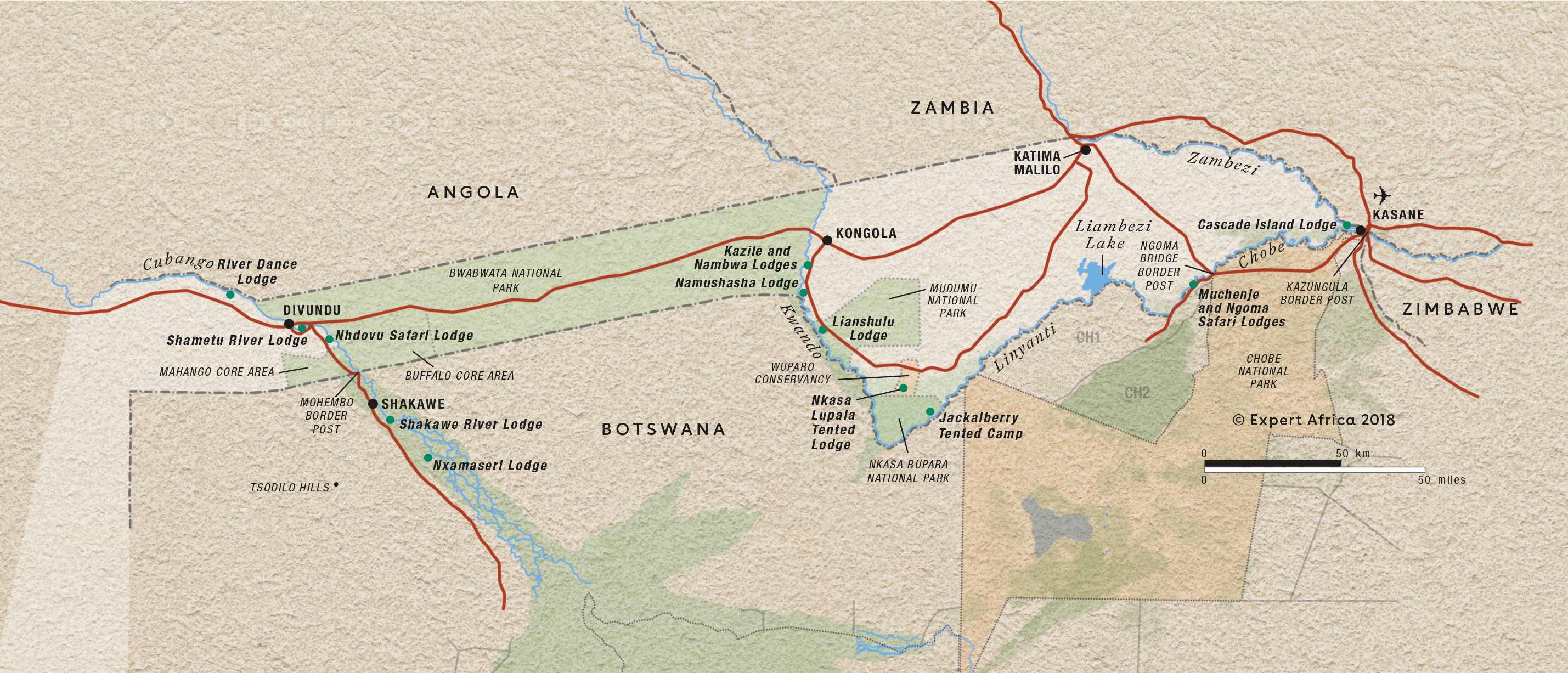
Caprivi Strip: Safaris

Pygmy Mouse Self-drive Safari
18 days • 10 locations
WINDHOEK AIRPORT TO VICTORIA FALLS AIRPORT
A truly epic southern African self-drive safari adventure from Namibia’s mountains and deserts, along the lush Caprivi Strip to Botswana and Victoria Falls in Zimbabwe, staying at luxury lodges throughout.
US$8,580 - US$10,260 per person

Great Egret Safari
12 days • 4 locations
MAUN AIRPORT TO VICTORIA FALLS AIRPORT
This wonderfully varied adventure combines Botswana's Okavango Delta and a live-aboard houseboat safari on the Chobe River, with big game in Zimbabwe's dry Hwange National Park and the stupendous Victoria Falls.
US$10,330 - US$17,370 per person

Rock Hare Self-drive Safari
20 days • 12 locations
WINDHOEK AIRPORT TO VICTORIA FALLS AIRPORT
An in-depth look at Namibia from the Namib Desert to the Caprivi, with additional stops in Botswana and Victoria Falls. This three-week adventure includes an unrivalled mix of environments and is great value.
US$7,230 - US$8,170 per person

Sable Self-drive Safari
12 days • 7 locations
WINDHOEK AIRPORT TO VICTORIA FALLS AIRPORT
A great-value southern African self-drive adventure from Namibia along the Caprivi Strip to Botswana and Zimbabwe, combining other-worldly landscapes, unforgettable wildlife spectacles and rarely visited places, and ending at Victoria Falls.
US$8,220 - US$9,120 per person
Our top 21 lodges and safari camps in Caprivi Strip
There are now many places to stay along the Caprivi Strip ranging from rustic simplicity to modern luxury. This area is continuing to develop rapidly with many new lodges having opened recently or planning to do so soon, speak to one of our experts to talk thought the options.

Ndhovu Safari Lodge
Ndhovu is a simple riverside lodge, with tents that are reminiscent of safaris a decade or two ago.

Hakusembe Lodge
Hakusembe River Lodge is a substantial lodge with a superb location on the Kavango River.

Chobe Princesses
The Chobe Princess houseboats offer a memorable way to explore the Chobe and Zambezi Rivers in Namibia's Caprivi. Perfect for a couple or for a group of family or friends.

Lianshulu Lodge
Beside the Kwando River, within Mudumu National Park, Lianshulu is a small safari lodge offering 4WD safaris and river trips – with particularly good birdlife.

Nkasa Lupala
Peaceful Nkasa Lupala is a comfortable lodge in a remote and little-explored area close to Nkasa Rupara National Park.

Nunda River Lodge
NNunda River Lodge overlooks a pretty part of the Kavango River near Popa Falls and the productive Mahango National Park.

Camp Kwando
Near to Mudumu National Park, Camp Kwando is a comfortable and unfussy option with opportunities for game drives, boat safaris and fishing.

Ichingo Chobe Lodge
Safari holiday in Namibia's Caprivi Strip, staying at Ichingo Chobe River Lodge on Impalila Island.

Nambwa Tented Lodge
A beautiful safari lodge In the remote Bwabwata National Park, Nambwa Tented Lodge brings serious comfort to a relaxing safari.

River Dance
Build on stilts on the banks of the Kavango River, River Dance Lodge has great views, a relaxed ambience and excellent birdlife.

Taranga Lodge
Situated on the banks of the Kavango, Taranga Safari Lodge works as a convenient stopover before going onto explore the Caprivi.

Zambezi Queen
The Zambezi Queen offers luxurious two- and three-night cruises along the game-rich Chobe River, including game viewing by small boat and 4WD as well as catch-and-release fishing.

Looking for inspiration on where to travel next?
Visit our trip chooser to explore your options and find inspiration for your perfect African adventure
Inspire me